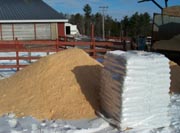Wood Pellet Bedding for Equines

- Method
- Results: Amount of Manure Removed From Stalls
- Results: Change In Nutrients and Moisture
- Results: Costs Comparison of Bedding Material
- Conclusion
Wood Pellet Bedding for Equines
By Donna Lamb, Piscataquis County Extension Educator, and Richard Kersbergen Waldo County Extension Educator
Situation: In a survey of equine owners conducted during the summer of 2000, 82 responses out of the 204 total responses received either hire or secure someone else to haul their manure away or have no removal plan at all. Many horse farms report problems with the huge volume of manure that they have to dispose or spread. Some horse keepers pay others to have their horse manure removed from the premise. Few if any have completed nutrient management plans.
The most recent New England Agriculture Statistics estimates that Maine has an estimated horse population of 17,000. This does not include most off-farm animals. The Maine Nutrient Management Training Manual estimates that horse manure and bedding is produced at a rate of 75 pounds or 3.7 cubic feet per animal unit per day in full confinement. This document also estimates the average animal weight for horses at 1000 pounds. If we estimate that horses are maintained in confinement 50% of the year, then the estimated volume of manure produced by equines in the State of Maine would be 116,344 tons or 425,157 cubic yards per year.
This project attempted to measure the different manure outputs from two different bedding materials. The traditional fresh sawdust bedding and a new pelleted wood product bedding was used.
1 Lamb, D. C., Review of 2000 Equine Survey Results for Maine, unpublished report, Piscataquis County Extension Office, Dover-Foxcroft, ME, December 2000.
2 New England Agricultural Statistics, New England Agricultural Statistics Service, Concord, NH, 1999, page 77.
3 Kersbergen, R., Developing Nutrient Management Plans for Maine Farms in Accordance with Chapter 565, University of Maine Cooperative Extension and Maine Department of Agriculture, Food and Rural Resources, December 1998, page 3.
